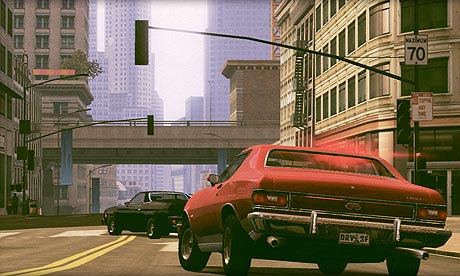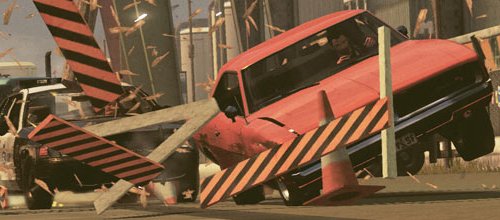
The campaign is set up in a way that you will always have side missions, and they stay available even after you’ve done them once. Usually these serve to unlock specific cars, but they’re also good for building Driver currency, known as Willpower (I don’t want to spoil the plot, so just accept that for what it is). Each story-driven mission has prerequisite missions as well, so you’ll experience a little more variety than the standard “drive here as fast as you can” schtick. If the mission structure has you confused, the easy way to break it down is: yellow icons are required to advanced the story, and blue icons are the extras. Willpower buys garages (there are over a half dozen scattered throughout the bay area), cars, and special abilities. Abilities include an extended boost meter, being able to see nearby collectibles on the radar, and even a cinematic camera that activates when you hit jumps and stunts in Free Roam.
The most criticism I’ve notice for Driver: SF (from other reviewers) is in regards to its plot. I gotta admit - this storyline is as hokey as they come. It’s original - in the most basic sense of the word - and borders on sci-fi...but probably my own biggest complaint is: whereas the origins of the Shift ability could have been a thrilling mystery, it’s explained to the player very early in the campaign. Taking away the “why can I” takes away the “why should I”, and I felt cheated out of what could have been a cool surprise at the end.
Luckily we’re still left with a great driving game, including online multiplayer and couch co-op. The online versus matches connect easily, allowing you to party up with friends or just hop straight into matchmaking. Progression is tracked, and rewards you with the ability to swap your car on the fly and to perform special maneuvers like ramming and boosting. Games of tag and races that include Shift ability for all players can get really hectic...and they’re just plain a lot of fun.
There is also a barebones race mode that disables Shift and offers a refreshing chance to get down to the central focus of the game: driving. In terms of couch co-op: you and one other person can play three splitscreen co-op modes, two of which are scenario-based and simple: one mode challenges both players to stop a racing team by using Shift and driving skills, another mode tasks you both with staying in close proximity to an escaping vehicle by following the trails of its taillights. The third co-op mode is simply splitscreen Free Roam. Once you've chosen a mode you're asked to pick from three available sectors of the map, and then the match starts. Unfortunately you cannot choose your starting vehicle (default cars in Free Roam are a 1970 Challenger for Player 1 and a 1968 Camaro SS for Player 2), but Shift allows you to jump into any other car you want. Some patience may be required if you're looking for a specific style or color.
Although it takes a minute in the menus to find it, you can actually open a Free Roam with a party of up to eight online players. Like Red Dead Redemption and Burnout: Paradise it can serve as a forum for friendly togetherness. You can jump your party into an online competitive game from Free Roam.
